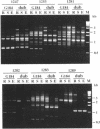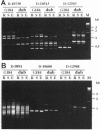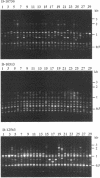Abstract
Clinical isolates of the fungal respiratory and systemic pathogen Histoplasma capsulatum have been placed in several different classes by using genomic restriction fragment length polymorphisms (RFLPs), but in general have not been distinguished further. We report here that a polymerase chain reaction (PCR)-based DNA fingerprinting method that has been termed arbitrary primer or random amplified polymorphic DNA (RAPD) PCR can distinguish among isolates in a single RFLP class. In this method, arbitrarily chosen oligonucleotides are used to prime DNA synthesis from genomic sites that they fortuitously match, or almost match, to generate strain-specific arrays of DNA fragments. Each of 29 isolates of RFLP class 2, the group endemic in the American Midwest, was distinguished by using just three arbitrary primers. In contrast, laboratory-derived S and E colony morphology variants of two strains were not distinguished from their R parents by using 18 such primers. Thus, the clinical isolates of H. capsulatum are quite diverse, but their genomes remain stable during laboratory culture. These outcomes suggest new possibilities for epidemiological analysis and studies of fungal populations in infected hosts.
Full text
PDF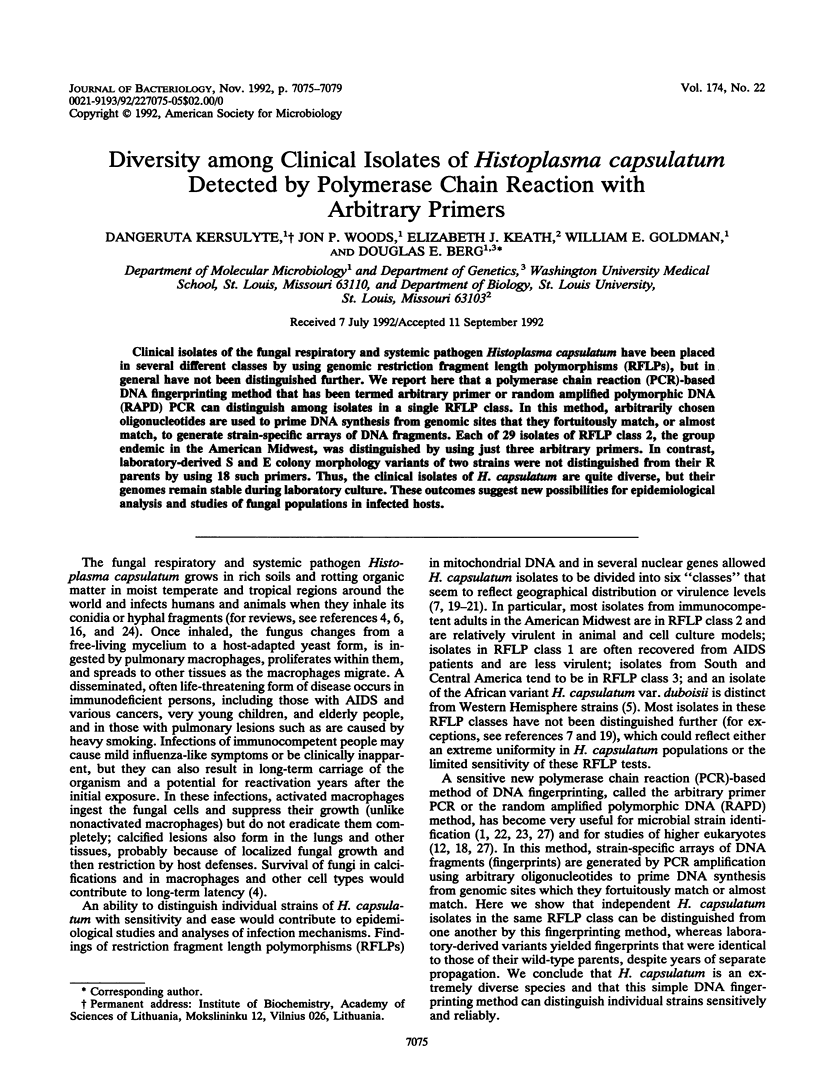
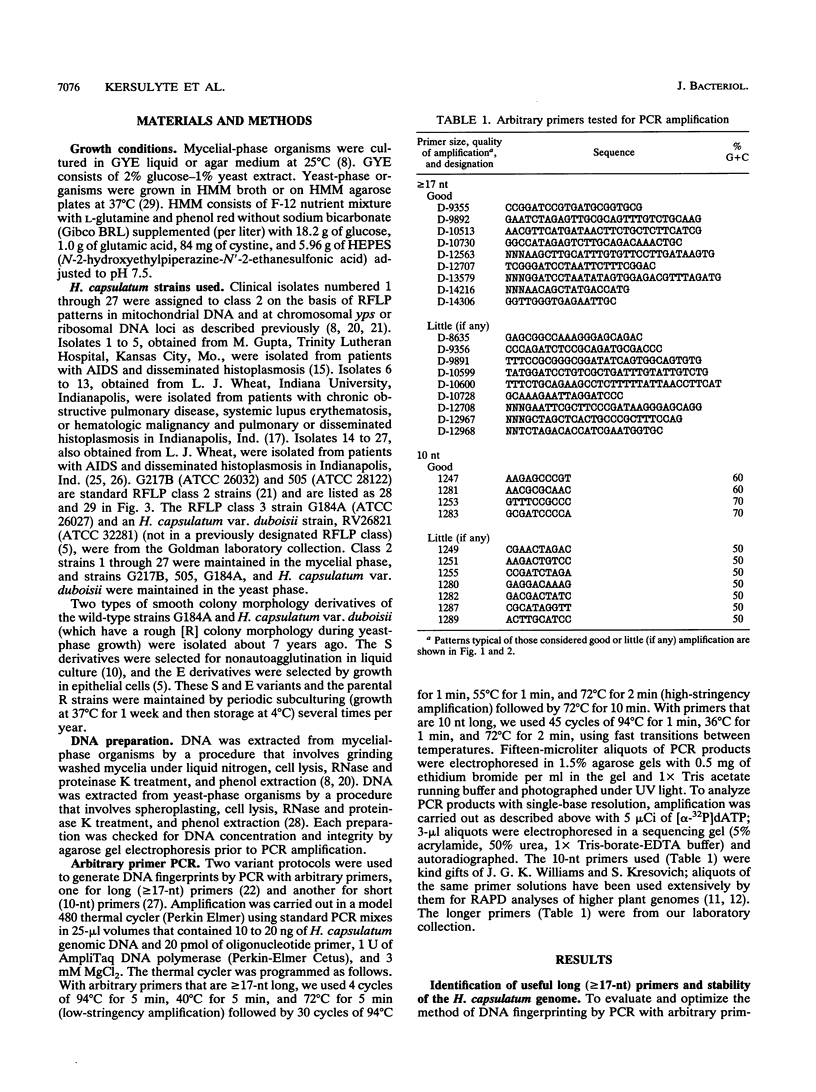
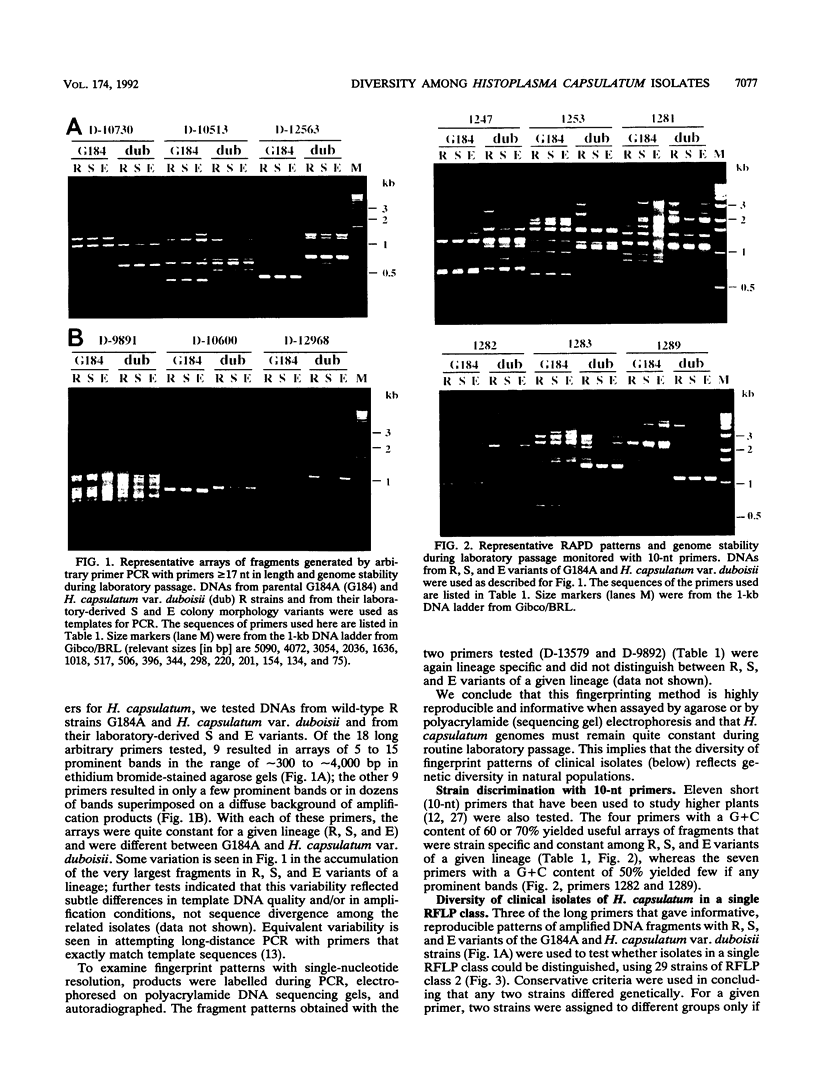
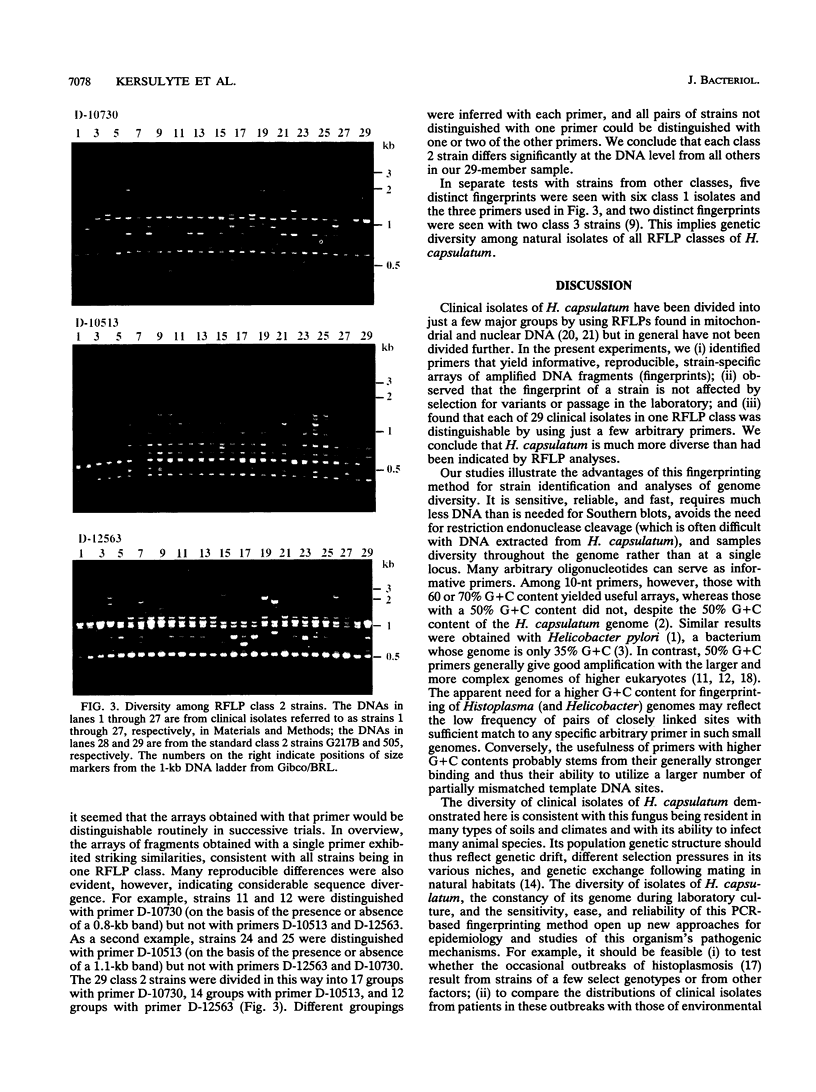
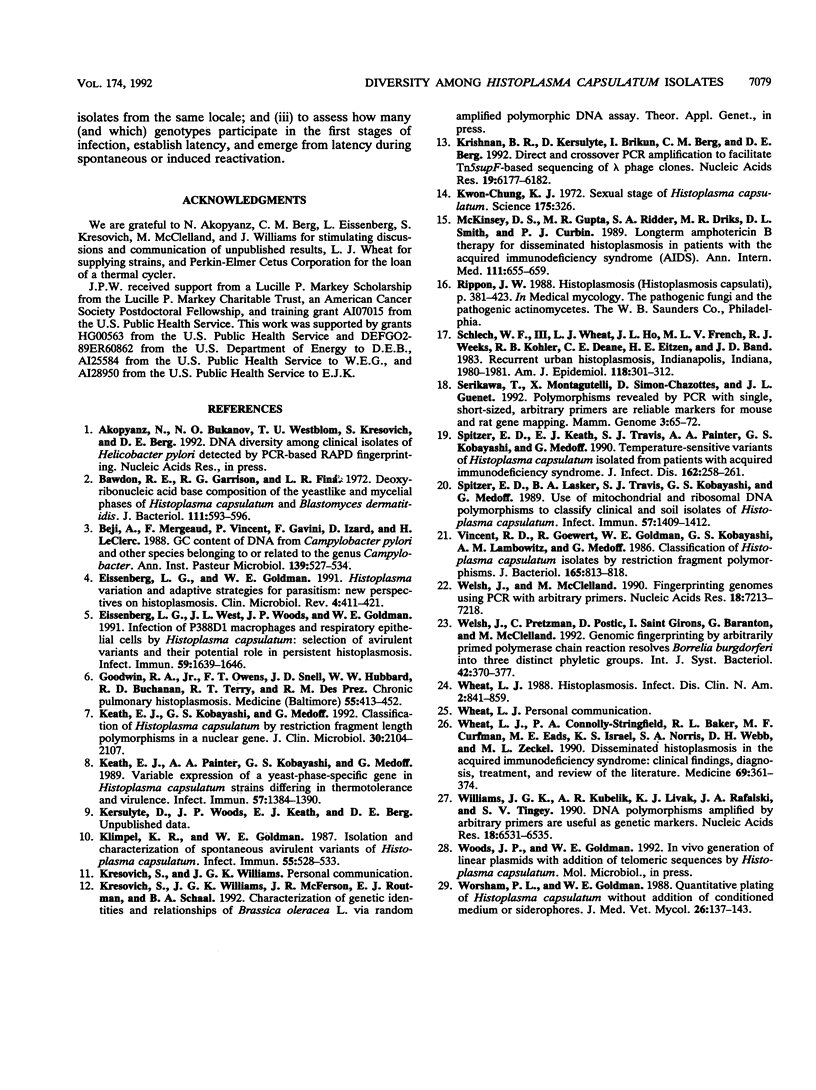
Images in this article
Selected References
These references are in PubMed. This may not be the complete list of references from this article.
- Bawdon R. E., Garrison R. G., Fina L. R. Deoxyribonucleic acid base composition of the yeastlike and mycelial phases of Histoplasma capsulatum and Blastomyces dermatitidis. J Bacteriol. 1972 Aug;111(2):593–596. doi: 10.1128/jb.111.2.593-596.1972. [DOI] [PMC free article] [PubMed] [Google Scholar]
- Béji A., Mégraud F., Vincent P., Gavini F., Izard D., Leclerc H. GC content of DNA of Campylobacter pylori and other species belonging or related to the genus Campylobacter. Ann Inst Pasteur Microbiol. 1988 Sep-Oct;139(5):527–534. doi: 10.1016/0769-2609(88)90152-4. [DOI] [PubMed] [Google Scholar]
- Eissenberg L. G., Goldman W. E. Histoplasma variation and adaptive strategies for parasitism: new perspectives on histoplasmosis. Clin Microbiol Rev. 1991 Oct;4(4):411–421. doi: 10.1128/cmr.4.4.411. [DOI] [PMC free article] [PubMed] [Google Scholar]
- Eissenberg L. G., West J. L., Woods J. P., Goldman W. E. Infection of P388D1 macrophages and respiratory epithelial cells by Histoplasma capsulatum: selection of avirulent variants and their potential role in persistent histoplasmosis. Infect Immun. 1991 May;59(5):1639–1646. doi: 10.1128/iai.59.5.1639-1646.1991. [DOI] [PMC free article] [PubMed] [Google Scholar]
- Keath E. J., Kobayashi G. S., Medoff G. Typing of Histoplasma capsulatum by restriction fragment length polymorphisms in a nuclear gene. J Clin Microbiol. 1992 Aug;30(8):2104–2107. doi: 10.1128/jcm.30.8.2104-2107.1992. [DOI] [PMC free article] [PubMed] [Google Scholar]
- Keath E. J., Painter A. A., Kobayashi G. S., Medoff G. Variable expression of a yeast-phase-specific gene in Histoplasma capsulatum strains differing in thermotolerance and virulence. Infect Immun. 1989 May;57(5):1384–1390. doi: 10.1128/iai.57.5.1384-1390.1989. [DOI] [PMC free article] [PubMed] [Google Scholar]
- Klimpel K. R., Goldman W. E. Isolation and characterization of spontaneous avirulent variants of Histoplasma capsulatum. Infect Immun. 1987 Mar;55(3):528–533. doi: 10.1128/iai.55.3.528-533.1987. [DOI] [PMC free article] [PubMed] [Google Scholar]
- Krishnan B. R., Kersulyte D., Brikun I., Berg C. M., Berg D. E. Direct and crossover PCR amplification to facilitate Tn5supF-based sequencing of lambda phage clones. Nucleic Acids Res. 1991 Nov 25;19(22):6177–6182. doi: 10.1093/nar/19.22.6177. [DOI] [PMC free article] [PubMed] [Google Scholar]
- Kwon-Chung K. J. Sexual stage of Histoplasma capsulatum. Science. 1972 Jan 21;175(4019):326–326. doi: 10.1126/science.175.4019.326. [DOI] [PubMed] [Google Scholar]
- McKinsey D. S., Gupta M. R., Riddler S. A., Driks M. R., Smith D. L., Kurtin P. J. Long-term amphotericin B therapy for disseminated histoplasmosis in patients with the acquired immunodeficiency syndrome (AIDS). Ann Intern Med. 1989 Oct 15;111(8):655–659. doi: 10.7326/0003-4819-111-8-655. [DOI] [PubMed] [Google Scholar]
- Schlech W. F., 3rd, Wheat L. J., Ho J. L., French M. L., Weeks R. J., Kohler R. B., Deane C. E., Eitzen H. E., Band J. D. Recurrent urban histoplasmosis, Indianapolis, Indiana, 1980-1981. Am J Epidemiol. 1983 Sep;118(3):301–312. doi: 10.1093/oxfordjournals.aje.a113637. [DOI] [PubMed] [Google Scholar]
- Serikawa T., Montagutelli X., Simon-Chazottes D., Guénet J. L. Polymorphisms revealed by PCR with single, short-sized, arbitrary primers are reliable markers for mouse and rat gene mapping. Mamm Genome. 1992;3(2):65–72. doi: 10.1007/BF00431248. [DOI] [PubMed] [Google Scholar]
- Spitzer E. D., Keath E. J., Travis S. J., Painter A. A., Kobayashi G. S., Medoff G. Temperature-sensitive variants of Histoplasma capsulatum isolated from patients with acquired immunodeficiency syndrome. J Infect Dis. 1990 Jul;162(1):258–261. doi: 10.1093/infdis/162.1.258. [DOI] [PubMed] [Google Scholar]
- Spitzer E. D., Lasker B. A., Travis S. J., Kobayashi G. S., Medoff G. Use of mitochondrial and ribosomal DNA polymorphisms to classify clinical and soil isolates of Histoplasma capsulatum. Infect Immun. 1989 May;57(5):1409–1412. doi: 10.1128/iai.57.5.1409-1412.1989. [DOI] [PMC free article] [PubMed] [Google Scholar]
- Vincent R. D., Goewert R., Goldman W. E., Kobayashi G. S., Lambowitz A. M., Medoff G. Classification of Histoplasma capsulatum isolates by restriction fragment polymorphisms. J Bacteriol. 1986 Mar;165(3):813–818. doi: 10.1128/jb.165.3.813-818.1986. [DOI] [PMC free article] [PubMed] [Google Scholar]
- Welsh J., McClelland M. Fingerprinting genomes using PCR with arbitrary primers. Nucleic Acids Res. 1990 Dec 25;18(24):7213–7218. doi: 10.1093/nar/18.24.7213. [DOI] [PMC free article] [PubMed] [Google Scholar]
- Welsh J., Pretzman C., Postic D., Saint Girons I., Baranton G., McClelland M. Genomic fingerprinting by arbitrarily primed polymerase chain reaction resolves Borrelia burgdorferi into three distinct phyletic groups. Int J Syst Bacteriol. 1992 Jul;42(3):370–377. doi: 10.1099/00207713-42-3-370. [DOI] [PubMed] [Google Scholar]
- Wheat L. J., Connolly-Stringfield P. A., Baker R. L., Curfman M. F., Eads M. E., Israel K. S., Norris S. A., Webb D. H., Zeckel M. L. Disseminated histoplasmosis in the acquired immune deficiency syndrome: clinical findings, diagnosis and treatment, and review of the literature. Medicine (Baltimore) 1990 Nov;69(6):361–374. doi: 10.1097/00005792-199011000-00004. [DOI] [PubMed] [Google Scholar]
- Wheat L. J. Systemic fungal infections: diagnosis and treatment. I. Histoplasmosis. Infect Dis Clin North Am. 1988 Dec;2(4):841–859. [PubMed] [Google Scholar]
- Williams J. G., Kubelik A. R., Livak K. J., Rafalski J. A., Tingey S. V. DNA polymorphisms amplified by arbitrary primers are useful as genetic markers. Nucleic Acids Res. 1990 Nov 25;18(22):6531–6535. doi: 10.1093/nar/18.22.6531. [DOI] [PMC free article] [PubMed] [Google Scholar]
- Worsham P. L., Goldman W. E. Quantitative plating of Histoplasma capsulatum without addition of conditioned medium or siderophores. J Med Vet Mycol. 1988 Jun;26(3):137–143. [PubMed] [Google Scholar]



